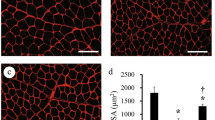Abstract
This study is concerned with the morphological recovery process of muscle spindles following a long period of immobilization. The right hindlimbs of rats were fixed with a plaster cast for 4 weeks. Thereafter, four groups of rats were examined by electron microscopy. One group served as the control after the cast was removed. The other three groups were examined after free walking for 4, 8, and 12 weeks, respectively. The muscle spindles (tibialis anterior muscle) of the individual animals were then ultrastructurally analyzed. The morphological alterations (of the outer capsule, intrafusal muscle fibers, and intrafusal nerve components) gradually recovered during free walking and regained almost all normal features in 12 weeks after returning to walking.
Similar content being viewed by others
References
Cooper RR (1972) Alterations during immobilization and regeneration of skeletal muscle in cats. J Bone Joint Surg [Am] 54:919–953
Booth FW (1978) Regrowth of atrophied skeletal muscle in adult rats after ending immobilization. J Appl Physiol Respir Environ Exercise Physiol 44:225–230
Booth FW, Seider MJ (1979) Recovery of skeletal muscle after 3mo of hindlimb immobilization in rats. J Appl Physiol 47:435–439
Appell HJ (1986) Morphology of immobilized skeletal muscle and the effects of a pre-and postimmobilization training program, Int J Sport Med 7:6–12
Chor H, Dolkart RE (1936) A study of “simple disuse atrophy” in the monkey. Am J Physiol 117:626–630
Furguson AB, Vaugham L, Ward L (1957) A study of disuse atrophy of skeletal muscle in the rabbit. J Bone Joint Surg [Am] 39:583–596
Tabary JC, Tabary C, Tardieu C, Tardieu G, Goldspink G (1972) Physiological and structural changes in the cat's soleus muscle due to immobilization at different lengths by plaster casts. J Physiol (Camb) 224:231–244
Booth FW, Kelso JR (1973) Production of rat muscle atrophy by cast fixation. J Appl Physiol 34:404–406
Tomanek RJ, Lund DD (1974) Degeneration of different types of skeletal muscle fibres. II. Immobization. J Anat 1185:531–541
Goldspink DF (1977) The influence of immobilization and stretch on protein turnover of rat skeletal muscle. J Physiol (Camb) 264:267–282
Booth FW (1977) Time course of muscle atrophy during immobilization of hind limbs in rats. J Appl Physiol Respir Environ Exercise Physiol 43:656–661
Jaffe DM, Terry RD, Spiro AJ (1978) Disuse atrophy of skeletal muscle. A morphometric study using image analysis. J Neurol Sci 35:189–200
Herbison GJ, Jaweed MM, Ditunno JF (1978) Muscle fiber atrophy after cast immobilization in the rat. Arch Phys Med Rehabil 59:301–305
Witzmann FA, Kim DH, Fitts RH (1982) Hindlimb immobilization: length-tension and contractile properties of skeletal muscle. J Appl Physiol Respir Environ Exercise Physiol 53:335–345
Booth FW (1987) Physiologic and biochemical effects of immobilization on muscle. Clin Orthop 219:15–20
Baker JH, Matsumoto DE (1988) Adaptation of skeletal muscle to immobilization in a shortened position. Muscle Nerve 2:231–244
Esaki K (1966) Morphological study of muscle spindle in atrophic muscle induced by immobilization with plaster cast. Nagoya Med J 12:185–210
Józsa L, Kvist M, Knnus P, Kannus P, Jarvinen M (1988) The effect of tenotomy and immobilization on muscle spindles and tendon organs of the rat calf muscles. A histochemical and morphometrical study. Acta Neuropathol 76:465–470
Kameda H (1993) Ultrastructural effects of immobilization on rat muscle spindles. Med Electron Microsc 26:65–75
Karnovsky MJ (1965) A formaldehyde-glutaraldehyde fixative of high osmolarity for use in electron microscopy (abstract). J Cell Biol 27:137–138
Elder GCB, McComas AJ (1987) Development of rat muscle during short-and long-term hindlimb suspension. J Appl Physiol 62:1917–1923
Morey-Holton E, Wronski J (1981) Animal models for simulating weight-lessness. Physiologist 24(supple):S45-S48
Deavers DR, Muscchia XJ, Meininger GA (1980) Model for antiorthostatic hypokinesis: head-down tilt effects on water and salt excretion. J Appl Physiol Respir Environ Exercise Physiol 49:576–582
Mussachia XJ, Steffen JM, Deavers DR (1981) Suspension restraint: induced hypokinesia and antiorthostasis as a simulation of weightlessness. Physiologist 24:S21-S22
Author information
Authors and Affiliations
Rights and permissions
About this article
Cite this article
Takahashi, Y., Kimura, M. Muscle spindles in immobilized muscle: electron microscopic study of recovery. Med Electron Microsc 30, 102–109 (1997). https://doi.org/10.1007/BF01545090
Received:
Accepted:
Issue Date:
DOI: https://doi.org/10.1007/BF01545090




